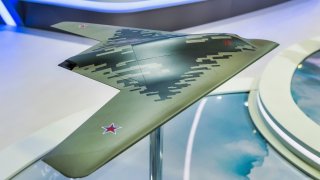Russia's S-70 Okhotnik-B Stealth Drone: We Have Questions
Two of the most prominent trends in aerospace development are one, stealth, and two, unmanned vehicles. Both trends have been combined in the ongoing development of Russia’s new stealth drone, the S-70 Okhotnik-B, a heavy unmanned combat aerial vehicle (UCAV).
S-70 Okhotnik-B, Explained: Two of the most prominent trends in aerospace development are one, stealth, and two, unmanned vehicles. Both trends have been combined in the ongoing development of Russia’s new stealth drone, the S-70 Okhotnik-B, a heavy unmanned combat aerial vehicle (UCAV).
Building the Future
As Elon Musk once famously predicted, the pilot’s era is rapidly coming to a close; the future of aerial combat will be unmanned. The remote piloting of otherwise manned aircraft, like the F-16, as well as the development of both autonomous and remote-piloted aircraft, suggest that the pilot’s era may indeed be concluding.
Of course, the era’s conclusion will take decades still, the world’s air forces still rely primarily on manned aircraft, with heavy investments made in brand-new manned aircraft like the F-35 and the F-15EX. However new programs are pushing the boundaries of unmanned capability. In time, no doubt, those unmanned capabilities will match manned capabilities, at which point the risk of strapping a pilot aboard an aircraft will no longer be worth the dangers and chance of human error imposed.
The Russians, for their part, have been developing the S-70 since 2011 or so. Rival firms, MiG and Sukhoi, have been collaborating to build the S-70, which is being billed as a sixth-generation unmanned aerial vehicle.
The S-70’s development has been a slow go, with the first taxiing tests occurring in 2018, and the first flight tests, with an altitude of just a few meters above the runway, occurring in Spring 2019.
By the end of summer 2019, the S-70 was being taken on short flights, with altitudes of 600 meters or so. Serial production was expected to begin before the end of 2024, but with just four weeks remaining in the year, and no production underway, that projection seems unlikely. To date, just two S-70s have been built. In fact, one was shot down over the skies of Ukraine.
The Russians used an Su-57 to shoot down the S-70 after the drone lost contact with ground control and flew into Ukrainian territory, fearing that the Ukrainians would recover the S-70 and glean tech secrets from the new drone. The Russians even went as far as to target the crash site with a missile, to further degrade the wreckage and reduce the likelihood that the Ukrainians recovered anything useful. However, the Ukrainian police reportedly recovered portions of the downed drone.
The S-70 features a flying wing design, featuring a sixty-five-foot-long wingspan. The drone has a maximum takeoff weight of 55,000 pounds and can carry up to 4400 pounds worth of guided and unguided munitions. The S-70 has a maximum speed of 620 miles per hour (Mach 0.82) and a range of 3,700 miles. For propulsion, the S-70 relies on one Al-41F-derived engine.
Given the heavy losses Russia is currently incurring in Ukraine, don’t expect stealth drone development to be a top-tier priority; a full-production run for the S-70 may not be in Putin’s near-term plans.
Harrison Kass is a defense and national security writer with over 1,000 total pieces on issues involving global affairs. An attorney, pilot, guitarist, and minor pro hockey player, Harrison joined the US Air Force as a Pilot Trainee but was medically discharged. Harrison holds a BA from Lake Forest College, a JD from the University of Oregon, and an MA from New York University. Harrison listens to Dokken.
Image Credit: Creative Commons and/or Shutterstock.

